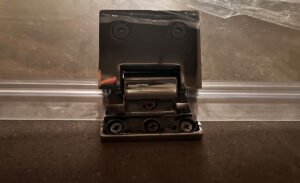Brass and stainless steel are two common materials that come into play when choosing the ideal shower door hardware. Each has particular advantages and disadvantages that affect durability, appearance, and general usability. With this thorough comparison, you should be able to make the right choice for your shower door hinges by selecting the material that best suits your needs.
The Beauty of Brass vs. The Sleekness of Stainless Steel
Brass Hinges: Exceptional Design in Every Detail
Shower door hinges made of brass are particularly attractive. Brass hinges are frequently used in visible applications where their look can enhance the overall design. They are available in a wide range of surface treatments, such as polished, antique, and brushed, to match any type of bathroom decor. Brass is a warm, golden colour that exudes refinement and richness, making it a great option for people who appreciate both quality and beauty.
Stainless Steel Hinges: Contemporary and Sleek
Stainless steel hinges provide a clean, contemporary appearance that goes well with modern bathroom decor. Stainless steel hinges are well-known for their smooth, shiny surface and ability to blend in perfectly with any environment, encouraging a minimalist and uncluttered look. This material is especially well-suited for people who like more understated designs that emphasize usefulness over style.
Extended Life Meets Practicality
Brass: Long-lasting and Low Maintenance
In addition to being aesthetically beautiful, brass is also very durable and low maintenance. Brass hinges are simple to clean and retain their shine with routine cleaning, making them ideal for places like restaurants and hospitals that have strict hygienic regulations. Over time, brass proves to be a cost-effective investment due to its longevity and low maintenance requirements, despite its higher initial cost.
Stainless Steel: Strong and Easy to Use
Strong and impervious to tarnish and corrosion, stainless steel is well known for these qualities. It is perfect for shower doors that are used frequently since it can tolerate rough handling and repeated use. Stainless steel hinges are low maintenance and typically only need a quick wipe down with a moist cloth to maintain their shiny appearance.
Versatility and Easy Operation
Brass Functions Smoothly
Brass hinges guarantee that shower doors function smoothly and effectively in addition to their aesthetic value. Brass’s natural qualities make it possible for doors to swing smoothly, improving user experience by making the process quiet and simple.
Design Versatility
Regarding design alternatives, brass is incredibly versatile, which might be important for custom bathroom renovations. Brass hinges may be made to satisfy a variety of aesthetic requirements, whether you’re going for a modern or vintage aesthetic. This makes them quite versatile for use in any type of bathroom.
Both Materials' Strength and Stability
Strong and resilient, brass and stainless steel can withstand heavy loads without buckling or cracking. No matter how often they are used, this strength guarantees that the shower doors will always be secure and solid.
Final Thought: The Ideal Material for Your Requirements
Depending on your demands and tastes, you can choose hinges made of brass or stainless steel. Brass is a great option if you value beauty above all else and are prepared to spend money on high-quality materials that will last. Stainless steel is the way to go if you want a cleaner, more contemporary appearance with less upkeep. Because these materials are dependable and long-lasting, they are strong competitors in the shower hinge market.




